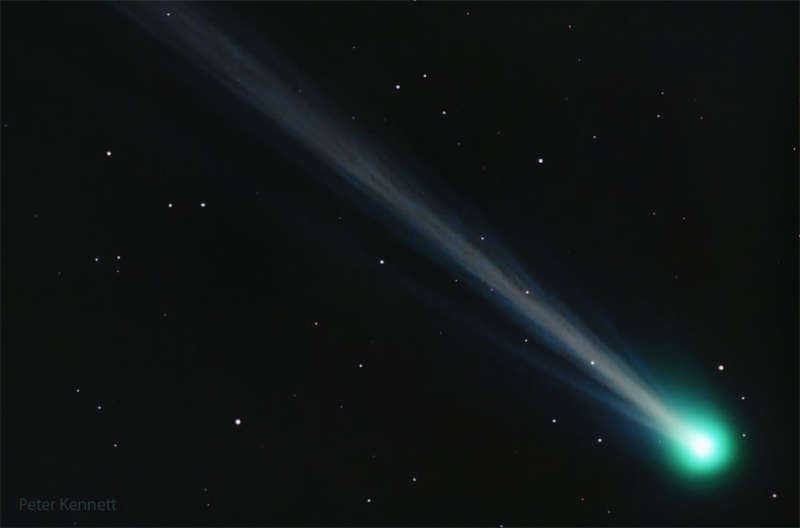
|
Credit & Copyright: Peter Kennett
Explanation:
Comet Nishimura is growing.
More precisely, the tails
C/2023 P1 (Nishimura)
are growing as it nears the Sun.
Discovered only last month, the
comet is already near
naked eye brightness as it now moves inside the Earth's orbit.
The comet will be nearest the
Earth next week, but nearest the Sun the week after -- on September 17.
Speculation holds that expelled ice and dust from
Comet Nishimura's last visit to the inner
Solar System may have created the
Sigma Hydrids
meteor shower which peaks yearly in December.
If so, then this
meteor shower may become more active,
refreshed with new
comet debris.
Pictured, Comet Nishimura was captured from
Edgewood,
New Mexico,
USA
four nights ago, showing a long ion tail structured by interactions with the
Sun's wind.
Look for this
comet near your
eastern horizon just before sunrise for the next few mornings,
but very near your
western horizon just after sunset next week -- as its coma
continues to brighten and its
tails continue to grow.
Gallery:
Selected Comet Nishimura images submitted to APOD
|
January February March April May June July August September October November December |
| ||||||||||||||||||||||||||||||||||||||||||||||||
NASA Web Site Statements, Warnings, and Disclaimers
NASA Official: Jay Norris. Specific rights apply.
A service of: LHEA at NASA / GSFC
& Michigan Tech. U.
Based on Astronomy Picture
Of the Day
Publications with keywords: comet
Publications with words: comet
See also:
- APOD: 2025 November 25 Á Comet Lemmon and the Milky Way
- 3I/ATLAS: A View from Planet Earth
- APOD: 2025 November 17 Á Comet Lemmons Wandering Tail
- APOD: 2025 September 30 Á Comet Lemmon Brightens
- APOD: 2025 September 29 Á Two Camera Comets in One Sky
- APOD: 2025 September 26 Á A SWAN an ATLAS and Mars
- APOD: 2025 September 18 Á Comet C/2025 R2 SWAN
